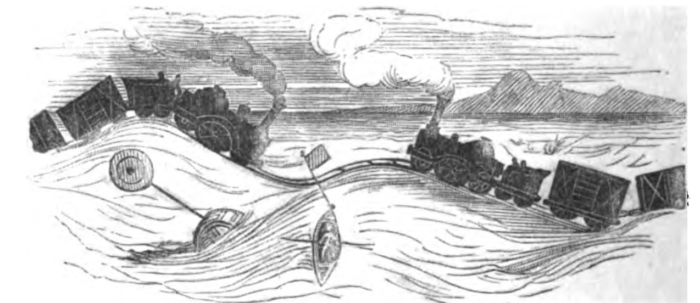From The Illustrated London News, January 2, 1858, Volume 32, January – June 1858
(From a Correspondent at Allahabad.)
I send you a sketch of a Railway Water-tank at Barwarie, twenty-three miles from Allahabad. The village in the distance is Barwarie. The dimensions of the tank were about 18 feet high, 22 feet long, 24 feet broad, and depth of tank 4 feet.
On Sunday, the 7th June, 1857, at noon, the day after the massacre at Allahabad, P. O Snow, railway engineer, Mr. J. Rose, Mr. Mathers, Mr. Leithbridge, wife and child, Mr. J. Keymer, wife and three children, Mr. R. Keymer, all employed on the railway, and Major and Mrs. Ryves, were assembled at the latter’s bungalow at Barwarie, when information was brought that Mr. Lancaster, an inspector, had been murdered, a mile off, when trying to join the above party. Immediately on receiving this news, Mr. Ryves and the women and children were assisted up on the top of the tank, we men intending to come down again for provisions &c.; but, as an immense number of armed natives begun to assemble, it was deemed more prudent to remain where we were, else we might have been cut off.
The natives commenced to loot, and destroy the furniture, &c., in the small bungalow (shown in the sketch) belonging to the railway contractors Messrs. Norris and Co., which having completed, they . went in a mass to my bungalow (about 100 yards in front of the tank), where they began to loot everything I was possessed of, even to taking off doom and windows, and breaking to pieces what they could not take away. Having completed this work of destruction they set fire to the bungalow, outhouses, and everything that would burn. Then, shouting and yelling, they rushed over and surrounded the tank by hundreds, throwing brickbats and stones at us. We kept them off with our guns. The top of the tank had no cover; and the women and children had to be protected by a mattress, which they sat under to prevent being killed by these missiles. The cowardly rascals kept this up constantly (several of us had severe contusions), at the same time demanding money, which we threw them. When they found we had no more left (having expended 3000 rupees), they wanted us to come down. We refused to do so They then brought straw and other inflammable matter, and piled it round the tank, and set fire to it, which caused a great suffering from the smoke and heat, but, the tank being of brick, it sustained no damage. Finding all their exertions to make us yield had failed, they said they would spare our lives if we all turned Mahometans. This, of course, one and all refused to accede to; a party was dispatched, saying the were going to muster a large armed force to escalade our stronghold during the night.; we told them we were prepared to sell our lives in protecting the woman and children. We were thus exposed (14 of us) with no covering from the fearful heat of the sun, very little water to drink, and only parched grain and boiled rice to eat for 52 hours; and had to defend our post against a mob of 3000.
On the morning of the 8th Mr. Smyth, an inspector, joined our party, very severely wounded, having had to run or his life, accompanied by Inspector Thomas, who was murdered that morning when on their way to join us. We pulled Mr. Smyth up to the top of the tank with ropes. This increased our party to 15. He was too weak from wounds to be of any assistance.
Having succeeded in getting a servant to take a note to the commanding officer at the fort of Allahabad, telling him of our position, a relief of 35 Irregular Cavalry were went out to us, and arrived at 4 p.m. on the 9th. Glad we were to see them, and a hearty cheer we gave them, inwardly returning thanks to God for this succour, as we should have had to fight hard for our lives that night. The distress of the poor women and children (without any conveniences) can hardly be supposed except by those who have experienced the heat of an Indian sun in the month of June. Mrs. Ryves was killed by its effects. She died in an hour after the relief had arrived, thus adding another victim to the long list of deaths occasioned by this awful rebellion.
The villagers, headed by the zemindars, were the people who looted, destroyed, and burnt all the railway gentlemen’s bungalows on the line.
T. J. Ryves

